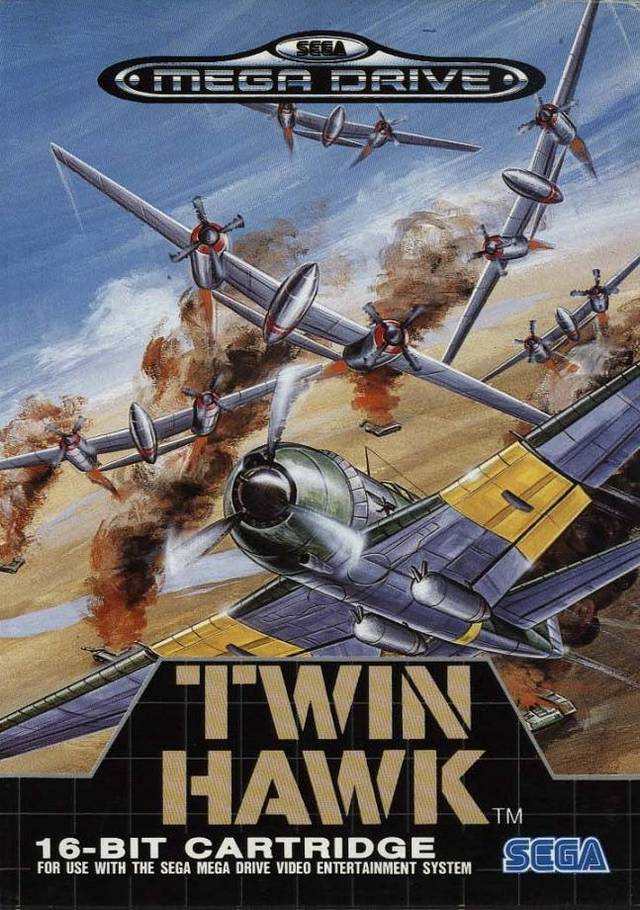

PLAYERS: 1
PUBLISHER: Sega
DEVELOPER: Toaplan
GENRE: Shoot-em-up
RELEASE DATE: 06/23/90 – (JP), 1990 – (EU)
Whereas Toaplan’s Truxton was an unrelenting vertical shooter set in outer space (with a screen-clearing bomb in the shape of a skull), Twin Hawk looks and plays like the developer’s re-imagining of Capcom’s 1942. The war-time vehicles, drab surroundings, and lack of power-ups all hearken back to simpler shoot-em-ups, even as the difficulty remains consistently high.

When Twin Hawk was released in arcades, it had two different plots, one for the Japanese version and one for the European version. The European version has “enemy forces” trying to conquer a foreign country by poisoning and drugging their food and water supply respectively. Here, you play as the Twin Hawk Flying Corp., a hastily assembled rebellion composed of fighter pilots.

In the Japanese version, you play as Big Whirlwind, an ace fighter pilot working for the President of Gorongo. Your mission is to stop the invading country of Fuangania from taking over Gorongo. Strangely, Fuangania has no airplanes, so their attacks all come from land or sea units. According to Wikipedia, this takes place in an alternate World War II timeline, which would explain why the enemies are, for the most part, realistic machines like tanks or ships. Thankfully, neither plot is necessary to understanding the game.

Twin Hawk‘s post-WWII setting is lifeless and dull. You fight near warehouses, deserts, and for long stretches on the ocean, that’s it. Realistic, sure, but Toaplan could have injected additional detail – little soldiers running between buildings or animals crawling on the ground – to make the environments come alive.

Big Whirlwind is initially outfitted with a two bullet stream (rapid-fire is available, though must be switched on via the options menu) and a special attack that calls in a back-up battalion of jet fighters. The bullet stream can be expanded with power-ups for a wider range of fire, but don’t expect any other weapons. Big Whirlwind was born with bullets, and he’ll die with bullets.

The battalion is the best part of Twin Hawk. When you call them in with the ‘B’ button, they fight both alongside and behind you. They move where you move and shoot where you shoot. They’re best used for hectic scenarios or, preferably, boss battles. If you wish, press ‘B’ again while the battalion is on-screen with you, and they’ll kamikaze into enemies. You can also forego the battalion entirely by pressing ‘B’ again before they reach the screen, and they’ll explode into a screen-clearing bomb.

Having additional firepower is necessary in Twin Hawk. Tanks of all sizes and strengths come in rows on either side of the screen, and Big Whirlwind, though mighty, travels slowly. Since there are no speed power-ups, the battalion is often crucial for making it through the more crowded portions of the game. Unfortunately, once you use your two battalion power-ups, there are only one or two extra ones found throughout the rest of the game. In order to use the battalion again, you’ll have to die to replenish your powerups.

For the amount of action taking place on screen, it’s amazing that Twin Hawk suffers from no slowdown. This is a technical achievement, no question, but it also means you can’t rely on decreased frames-per-second to help you navigate through the chaos. Like most Toaplan shooters, Twin Hawk is tough, even on the Easy setting.

There are only four levels, all of which merge into each other and eventually repeat once you’ve beaten the game. The soundtrack stops and restarts with a new track every time you enter a new level; without that musical cue, you won’t know that you’re in a new level, as they don’t always end with boss fights. The vibrant soundtrack and constant barrage of enemies keeps your pace steady, and you likely won’t be bored while playing. Once you’ve beaten Twin Hawk, however, there’s no reason to play it again, unless you want to tackle it on a higher difficulty.

While still a challenge, Twin Hawk is slightly less overwhelming than what I’m used to with Toaplan, and thus, could be considered a good entry point into their catalog of challenging shoot-em-ups. Its drab backdrop and slower pace probably won’t keep more hardcore shmup fans’ attention, though. Particularly when shoot-em-ups like Thunder Force III (which released two weeks prior to Twin Hawk in Japan) provide additional depth alongside gorgeous visual aesthetics. Still, if you keep your expectations low and your thumb game strong, Twin Hawk will fill that “must destroy everything” void, if only for a moment.
B-


7 replies on “Twin Hawk (Mega Drive, 1990)”
Big Whirlwind is such a great name. It sounds like a boxer or something.
Agreed.
I wonder if you have to beat the game twice to get the real ending like you did with Truxton? It might explain that ending message.
I wondered that too, but when I looked for info, I couldn’t find it.
I haven’t played this, but it sounds as though you have some better Toaplan shooters in your near future. I’ve spent a lot of time with Fireshark and Twin Cobra, which must represent the two extremes of Toaplan’s difficulty spectrum.
Yeah, I’m looking forward to exploring more of their catalog.
It’s interesting that VG Price Charting doesn’t have a listing for this game at all, even though there are entries on eBay. VGPrice.com lists a loose cart at nearly $25, which isn’t really a good price for the game, considering it’s definitely one of the lesser Toaplan titles. By way of example, Fire Shark craps all over this game. That said, I’ve enjoyed what I’ve played of Twin Hawk/Daisenpu via emulation, and as a shmup enthusiast, I would definitely like to find a complete copy of this at some point. It’s fun for what it is, as you say, but definitely go in with low expectations.